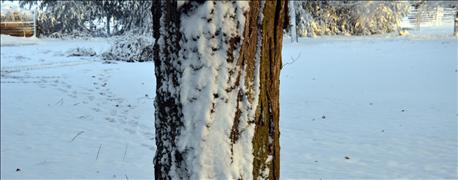November 3, 2016

Weather Wise asks questions that many people think about but seldom verbalize. You’ve likely heard about "lake-effect snow" in northern Indiana. If you live there or have relatives who do, you know it is for real.
Here is this month’s Weather Wise question:
What is the science behind lake-effect snow? Can it literally snow a foot in one place and none 2 miles away? Is that fact or myth?
Answer: Lake-effect snow is a weather event where narrow bands of heavy snow fall near the shores of lakes during wintertime. In the U.S., this phenomenon is most well-known and observed on the eastern shores of the Great Lakes.

NOW YOU SEE IT … Now you don’t see it. Just like snow gathered on one side of this tree and not the other, lake-effect snow turns on and off almost on a dime.
As cold winds sweep long distances over warm, unfrozen lake water, moisture and heat from the lake rise into the colder onshore atmosphere. It condenses into narrow bands of clouds that may drop heavy snow past the shoreline.
These narrow bands of snow can fall at rates of 2 to 3 inches per hour or more. Later in winter, after surface lake water freezes, less moisture is available. The lake effect can shut down later in the season.
Fact!
According to the National Weather Service: “Wind direction is a key component in determining which areas will receive lake-effect snow. Heavy snow may be falling in one location, while the sun may be shining just a mile or 2 away in either direction.”
Because of this, it’s possible for it to snow a foot or more in a few hours in one area, yet people who live just down the road never see a flake.
Most lake-effect snow falls within 25 miles of shore, but some moisture can travel up to 100 miles inland. South Bend, inland and southeast of the Lake Michigan shoreline, is a prime location for lake-effect snow.
The “snow capital” of Indiana is nearby at New Carlisle. Yet the Lake Michigan effect can also occur farther inland. It can carry snow as far as Elkhart, Logansport and even Kokomo, if wind speeds are strong and from a precise direction.
The shoreline areas of Wisconsin, upper and western Michigan, Pennsylvania, upstate New York and southern Ontario are other areas that experience lake-effect snow. Michigan’s Upper Peninsula and northwestern New York are among the snowiest areas in the continental U.S. due to the lake effect.
Eggert works in the Indiana State Climate Office. He writes from West Lafayette.
Send a question! Do you have an unsolved riddle related to weather? Send it to Indiana Prairie Farmer and we will consider it for a future edition of Weather Wise. Mail it to: P.O. Box 247, Franklin, IN 46131, or email [email protected].
You May Also Like




